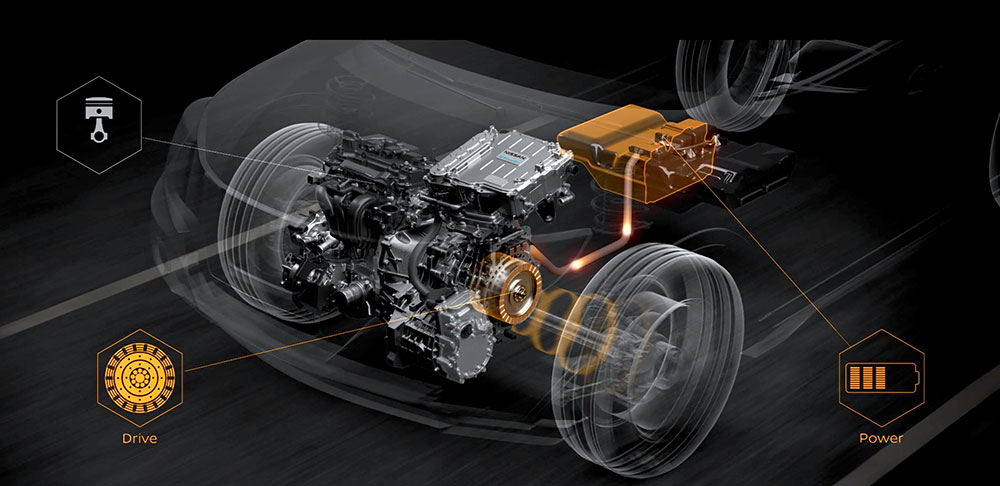Nissan’s new e-Power play

Nissan Australia will launch its thrifty e-Power technology on versions of the new X-Trail and Qashqai models in early 2023, but the company is at pains to avoid calling these new models hybrids, despite evidence to the contrary.
As Nissan points out, in conventional hybrid vehicles, such as those popularised by Toyota, both the internal combustion engine and the electric motor can power the vehicle, either individually or together.
However, in the case of the Nissan e-Power models the petrol engine only ever works as a generator for the car’s lithium-ion battery pack, which then provides power to an electric motor via an inverter, with the electric motor exclusively driving the wheels.
While Nissan’s application of the technology may be new, the idea is not and such ‘series hybrids’ or ‘range extenders’ as they’re also known have been seen previously on models including the Holden Volt and BMW i3.
Nevertheless, Nissan claims its e-Power models drive just like an electric vehicle, with the same instant torque and seamless power delivery thanks to the absence of a gearbox, and with the 1.5-litre variable compression turbocharged three-cylinder petrol engine working “quietly in the background”.
Unlike a regular battery electric vehicle which needs to be plugged into an electricity point to recharge, however, the Nissans still need to be filled with petrol, albeit less regularly than their conventionally powered counterparts.
In the case of the X-Trail, e-Power variants boast lower combined cycle fuel consumption of 6.1L/100km, versus between 7.4 and 7.8L/100km for its 2.5-litre four-cylinder petrol stablemates.

That’s a handy reduction in fuel consumption but it comes at a price, with the X-Trail e-Power costing $54,190 for the Ti and $57,190 for the Ti-L, an increase of $4200 over the equivalent petrol-powered models.
Both X-Trail e-Power variants also feature Nissan’s new e-Force all-wheel drive system, developed specifically for electrified powertrains.
It places an electric motor at each axle, improving traction and performance, with Nissan claiming the technology reacts to changes in grip levels “10,000 times faster than traditional all-wheel drive technologies”.
The petrol-powered version of the X-Trail went on sale in late November, but the e-Power variants are not due until early 2023.
Meanwhile, the launch date for the e-Power Qashqai SUV is likely to be further off again, with Nissan launching the petrol versions of its new small SUV in mid-December, but avoiding being more specific about when the e-Power versions will arrive other than “sometime in 2023”.
Pricing for the Qashqai e-Power has also not been confirmed but the 1.3-litre four-cylinder petrol-turbo models start at $33,890 for the entry-level ST, and rise through seven variants to the Ti with two-tone pain at $47,890.
Based on this, expect the e-Power variants to be close to $50,000 and to be front-wheel drive only, like the rest of the Qashqai range.
Learn more about the electric future
Related topics
Things to note
The information in this article has been prepared for general information purposes only and is not intended as legal advice or specific advice to any particular person. Any advice contained in the document is general advice, not intended as legal advice or professional advice and does not take into account any person’s particular circumstances. Before acting on anything based on this advice you should consider its appropriateness to you, having regard to your objectives and needs.
Insurance Products (excluding Travel Insurance) are issued by RACQ Insurance Limited ABN 50 009 704 152 (RACQI) and arranged by its agent, RACQ Distribution Services Pty Ltd (RDS) ABN 35 116 361 650, AFSL 567130 and RDS' authorised representatives (including RACQ Operations Pty Ltd ABN 80 009 663 414, AR No. 234978 (RACQO). Conditions, limits and exclusions apply. RDS and RACQO are in the RACQ group of companies. One of the companies in the RACQ group of companies has a minority shareholding in RACQI.
RDS and RACQO have not taken your personal objectives, circumstances or needs into account when preparing advice regarding insurance products and you will need to consider whether the advice is appropriate for you. Read the Product Disclosure Statement (PDS) and any applicable Supplementary PDS before making a purchase decision on this product. You can also access our Target Market Determinations on this website. RDS receives a commission from RACQI for the policies it arranges. RACQO receives fees paid for services it provides to RDS. Further details about remuneration are available on request prior to purchasing.
Banking and loan products issued by Members Banking Group Limited ABN 83 087 651 054 AFSL/Australian credit licence 241195 trading as RACQ Bank. Terms, conditions, fees, charges and lending policies apply. This is general advice only and may not be right for you. This information does not take your personal objectives, circumstances or needs into account. Read the disclosure documents for your selected product or service, including the Financial Services Guide and the Terms and Conditions, and consider if appropriate for you before deciding.
Except for RACQ Bank, any RACQ entity referred to on this page is not an authorised deposit-taking institution for the purposes of the Banking Act 1959 (Cth). That entity’s obligations do not represent deposits or other liabilities of RACQ Bank. RACQ Bank does not guarantee or otherwise provide assurance in respect of the obligations of that entity, unless noted otherwise.
RACQ Bank subscribes to the Customer Owned Banking Code of Practice which establishes higher standards than the law requires. The Code reflects modern consumer expectations and developments in approaches to issues such as consumer vulnerability, guarantors, and supporting customers through financial hardship. Please read our Customer Owned Banking Code of Practice page for more information.
RACQ Operations Pty Ltd (ABN 80 009 663 414 AR 000234978) and Members Travel Group Pty Ltd (ABN 45 144 538 803 AR 000432492) are acting as an Authorised Representative of the issuer of the insurance, Tokio Marine & Nichido Fire Insurance Co., Ltd. (ABN 80 000 438 291 AFSL 246 548). Any advice set out above is general in nature only, and does not take into account your objectives, financial situation or needs. Before purchasing any travel products, please consider the RACQ Travel Insurance Product Disclosure Statement (PDS) and the Target Market Determinations (TMDs) that apply to these products. Whilst the PDS outlines the Terms and Conditions of these products, the TMDs outline the intended class of customers that comprise the target market for these travel products. This will allow you to consider which products best suit your objectives, financial situation and needs and consider the products appropriateness to your personal circumstances. TMDs also outline matters involving the distribution and the review of these products. The PDS, Supplementary PDS and TMDs for each travel product can be found here.

